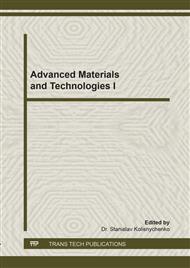[1]
Kim T W, Sahimi M, Tsotsis T T. Chem Eng Sci, 2009, 64: 1585.
Google Scholar
[2]
Yuxuan Chen, Zhonghe Shui, Wei Chen, et al. Construction and Building Materials. 93(2015) 1051-1058.
Google Scholar
[3]
Mohsen S. Mostafa, Al-Sayed A. Bakr, Ahmed M.A. El Naggar, et al. Journal of Colloid and Interface Science. 461(2016)261-272.
Google Scholar
[4]
Ling Pang, Kuangyi Liu, Shaopeng Wu, et al. Construction and Building Materials. 67(2014)239-243.
Google Scholar
[5]
Vladimir Jurisic, Tatjana Terzic, Sonja Pavlovic, et al. Pathology-Research and Practice. 204(2008)129-132.
Google Scholar
[6]
Pankaj Suresh Ghomade, Narendra Baluram Kumar, Chaitanya Vidyadhar Tingne, et al. Journal of Forensic and Legal Medicine. 28(2014)42-46.
Google Scholar
[7]
Jianchao Sun, Yanbing Zhang, Juan Cheng, et al. Journal of Molecular Catalysis A: Chemical. 382(2014)146-153.
Google Scholar
[8]
Xiangrong Ma, Hongjuan Li, Gang Zhu, et al. Colloids and Surfaces A: Physicochem. and Eng. Aspects. 371(2010)71-75.
Google Scholar
[9]
Xinhong Qiu, Keiko Sasaki, Kwadwo Osseo-Asare, et al. Journal of Colloid and Interface Science. 445(2015)183-194.
Google Scholar
[10]
G. Mascolo, M.C. Mascolo. Microporous and Mesoporous Materials. 214(2015)246-248.
Google Scholar
[11]
Wenmiao Lv, Lei Yang, Binbin Fan, et al. Chemical Engineering Journal. 263(2015)309-316.
Google Scholar
[12]
Yanqin Shi, Feng Chen, Jingtao Yang, et al. Applied Clay Science. 50(2010)87-91.
Google Scholar
[13]
M. Maciejewska, A. Krzywania-Kaliszewska, M. Zaborski, J. Chromatogr. A. 1257(2012)141.
Google Scholar
[14]
D. Yuan, L. Zhou, D. Fu. Applied Physics a-Materials Science & Processing, 2017, 123: 146-154.
Google Scholar
[15]
Zhou Liangqin, Fu Dayou, Yuan Dong, et al. Chinese Journal of Chromatograph. 2015, 33(1): 96-100.
Google Scholar
[16]
M. Rückriem, D. Enke, T. Hahn. Microporous and Mesoporous Materials. 209(2015)99-104.
DOI: 10.1016/j.micromeso.2014.08.053
Google Scholar
[17]
Maria Dimopoulou, Christos Ritzoulis, Costas Panayiotou. Colloids and Surfaces A: Physicochem. Eng. Aspects. 475(2015)37-43.
Google Scholar
[18]
Lilya Boudriche, Rachel Calvet, Boualem Hamdi, et al. Colloids and Surfaces A: Physicochem. Eng. Aspects. 399(2012)1-10.
Google Scholar
[19]
Hadjittofis E ,Zhang GGZ, Heng JYY. RSC ADVANCES, 2017,20(7):12194-12200.
Google Scholar
[20]
G.M. Dorris, D. G.Gray, J. Colloid Interface Sci. 77(1980)353.
Google Scholar
[21]
Hamieth T, Schultz J. J Chromatogr A.2002, 969:17.
Google Scholar
[22]
Henryk Grajek. Journal of Chromatography A. 1145(2007)1-50.
Google Scholar
[23]
M Nardin, H Balard, E Papirer. Carbon. 28(1990)43-48.
Google Scholar
[24]
Li S, Ren LL, Bai ZM . APPLIED SURFACE SCIENCE, 2019,470:979-990.
Google Scholar
[25]
Tae-Bong Hur, TranX.Phuoc, Minking K. Chyu. Optics and Lasters in Engeering. 47(2009) 695-700.
Google Scholar
[26]
Debek R, Wierzbicki D, Motak M,et al. PLASMA SCIENCE & TECHNOLOGY, 2019, 21(4):1-20.
Google Scholar
[27]
ZHAO Yue-Chang, LIU Ling, CHENG Wen-Ping,et,al. Journal of Inorganic Materials. 24(2009):171-174.
Google Scholar
[28]
Xu jinfang. Zhejiang University of technology, (2015).
Google Scholar
[29]
A. Voelkel, E. Andrzejewska, H. Limanowska-Shaw, et al. Applied Surface Science. 245(2005)149-154.
DOI: 10.1016/j.apsusc.2004.10.004
Google Scholar
[30]
J.A.F. Gamelas, A.G. Colloids and Surfaces A: Physicochem. Eng. Aspects. 478(2015)62-70.
Google Scholar
[31]
Ma P S. Experimental Property Data Handbook of Organic Chemicals. Beijing: Chemical Industry Press, 2006:8.
Google Scholar
[32]
Omar K. Duaij, Ali Alghamdi, Zeki Y. Al-Saigh. Journal of Chromatography A. 1291(2013)137-145.
Google Scholar


